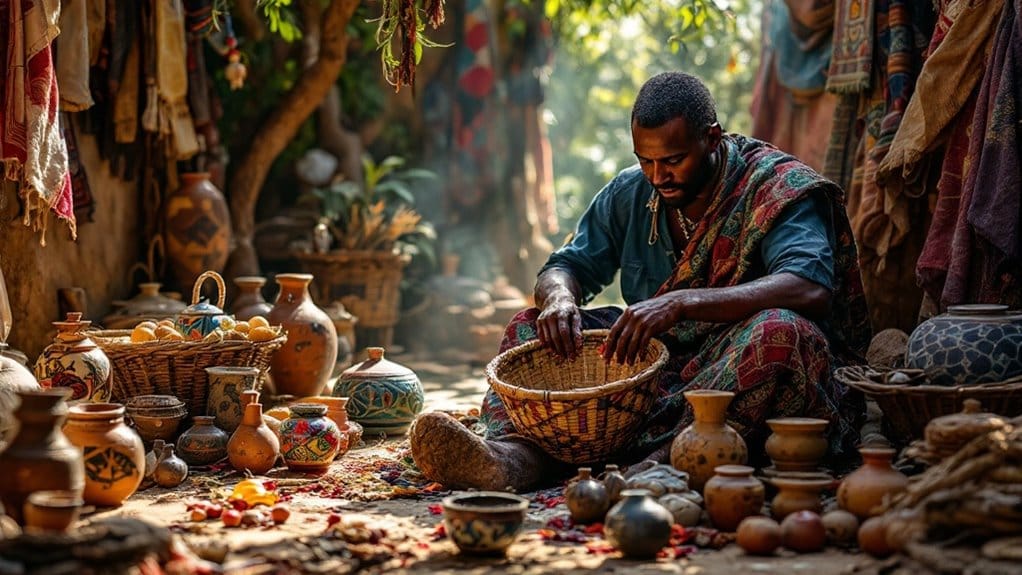Understanding African Indigenous crafts helps you appreciate the deep cultural significance embedded within them. Each craft item tells a story, reflecting community values and spiritual beliefs. For example, Kente cloth patterns symbolize social identities while masks and sculptures honor ancestors. These crafts not only preserve age-old techniques but also contribute economically, providing livelihoods for many artisans. Their global influence bridges traditional methods with contemporary styles, showcasing resilience and creativity. As you explore further, you'll uncover how these vibrant expressions shape identities and foster community ties across generations.
Key Takeaways
- African indigenous crafts reflect deep cultural heritage, with practices rooted in history that date back thousands of years.
- Craftsmanship serves as a vital medium for storytelling, expressing community values through unique patterns and symbols.
- Indigenous crafts support local economies, providing sustenance for artisans and promoting sustainable development through fair trade practices.
- Diverse techniques and materials used in crafting showcase cultural identity, with each region exhibiting unique artistic expressions.
- Global collaborations and art initiatives amplify the significance of African crafts, fostering cross-cultural exchanges and contemporary relevance.
Historical Roots of African Crafts
Craftsmanship in Africa has deep historical roots that span thousands of years, reflecting the rich cultural heritage of the continent. You'll find that African crafts aren't just art but an essential expression of cultural identity tied to community values.
From the earliest evidence of bead-making over 72,000 years ago to the sophisticated terracotta sculptures of the Nok culture, traditional craftsmanship has flourished through the ages. Each piece tells a story, showcasing intricate designs that carry meaning and significance.
The evolution of utilitarian and decorative craftsmanship is remarkable. Traditional pottery, dating back to at least 100 B.C., highlights the importance of function and beauty in daily life.
Textiles like kente cloth are steeped in history, with designs passed down through generations, symbolizing social identity. Trade routes across Africa have played a critical role in sharing techniques and materials, enriching the diversity of artistic expressions we see today.
As you explore these crafts, you'll uncover a tapestry of heritage that connects communities and celebrates the spirit of African artistry. Embrace this journey into the past, and you'll discover the heartbeat of a continent woven into every creation.
Cultural Expressions Through Craftsmanship
Throughout Africa, craftsmanship serves as a powerful medium for cultural expression, with each art form telling stories that resonate deeply within communities. African craftsmanship, from intricate beadwork to vibrant textiles, reflects the rich tapestry of cultural identity that binds people together. Each piece carries layers of meaning, embodying community history and showcasing artistic heritage.
Consider the unique patterns of Kente cloth or the symbolic Adinkra symbols; they're not just fabric but storytelling mediums that convey values and traditions. Masks and sculptures connect us to spiritual beliefs, often used in ceremonies to honor ancestors and bridge the physical and spiritual dimensions. These art forms reinforce cultural practices, reminding us of our roots.
The diversity in craftsmanship highlights regional distinctions, celebrating the adaptive spirit of various communities. Whether it's pottery that combines functionality with artistry or beautifully woven textiles, every creation preserves traditional methods while embracing modern influences.
Economic Benefits of Indigenous Crafts
Indigenous crafts aren't just beautiful expressions of culture; they're also crucial economic engines for communities across Africa. By supporting artisans, you're directly contributing to local economies and fostering economic stability. Millions of artisans rely on the sale of handmade crafts to sustain their families, creating a ripple effect that promotes sustainable development within their communities.
When you choose to buy indigenous crafts, you help preserve traditional techniques and cultural heritage. Fair trade practices guarantee that artisans receive fair compensation, creating a more equitable market. Additionally, exporting crafts opens up international trade opportunities, allowing African artistry to shine on a global stage and boosting sales in growing markets.
Craft markets play an essential role in community development, as proceeds often get reinvested into local initiatives like education, healthcare, and infrastructure improvements. By engaging with these markets, you're not just purchasing a beautiful item; you're investing in the future of these communities.
Techniques and Materials in Crafting
Drawing on a rich tapestry of cultural heritage, African artisans utilize a diverse array of techniques and materials in their crafting processes. The traditional African arts they create reflect a profound connection to their cultural identity.
For instance, wood is mainly used for crafting intricate sculptures and masks, which embody spiritual significance and serve as a link to ancestral traditions.
When it comes to textiles, artisans employ intricate weaving techniques with natural fibers, producing vibrant textiles like Kente cloth. These colorful patterns not only showcase artistic skill but also convey important social meanings.
Beadwork is another essential craft form, where artisans use locally sourced materials such as glass, clay, and seeds. The colors and designs in beadwork symbolize social status and reinforce community ties.
Pottery techniques vary by region, with artisans shaping clay into both functional and decorative pieces. These pottery items often feature unique glazing and firing methods that reflect local aesthetics.
Global Influence of African Artisans
The global influence of African artisans is an indication of the resilience and creativity embedded in their crafts. You can see this in the recognition gained through initiatives like the Sindika Dokolo African Collection at the 2007 Venice Biennale, which celebrated contemporary African artists and their unique contributions.
Hand-painted movie posters from Ghana have also carved out a niche, inspiring contemporary artists to blend traditional techniques with modern themes, enhancing visibility for African art worldwide.
Art biennials in cities like Dakar and Johannesburg are crucial platforms for African artisans, fostering cross-cultural exchanges that amplify the significance of their work. By integrating traditional techniques and motifs into contemporary designs, they've inspired various industries, from fashion to home decor, showcasing the richness of African craftsmanship and cultural identity.
Collaborations between African artisans and international designers further highlight this global influence, leading to innovative fusion designs that resonate in global markets. Through diverse materials and artistic heritage, these artisans not only preserve their culture but also invite the world to appreciate the depth and beauty of their crafts, creating a sense of belonging in a global community.
Frequently Asked Questions
What Is the Cultural Significance of African Art?
African art holds deep cultural significance, as it embodies community identity and rich storytelling methods.
You'll find that its vibrant pieces often reflect African symbolism and spiritual connections, while showcasing unique craft techniques that preserve artistic expression.
The materials used carry significance, highlighting the region's heritage.
Through these creations, generational knowledge is passed down, ensuring the art's preservation and reinforcing connections to cultural heritage that resonate within communities across the continent.
Why Are Traditional Crafts Important to a Culture?
Imagine a grandmother teaching you to weave a basket; each twist of the fiber tells a story of your ancestors.
Traditional crafts are essential to a culture because they preserve heritage and foster community bonding. They serve as storytelling mediums, where artistic expression reflects cultural identity.
Through skill transmission, you connect generations, appreciate your roots, and empower your community economically while promoting environmental sustainability.
Embracing these crafts strengthens intergenerational ties and enriches lives.
What Is the Significance of Indigenous Arts and Crafts?
Indigenous arts and crafts hold deep significance as they embody community identity and artistic expression.
You'll find that these crafts use indigenous techniques, showcasing cultural heritage and storytelling methods that connect generations. They foster social cohesion and reflect spiritual beliefs, reinforcing bonds within communities.
Plus, they drive economic empowerment and promote environmental sustainability, ensuring artisans thrive.
When you engage with these crafts, you participate in a rich tapestry of intergenerational knowledge and shared heritage.
Why Is Traditional African Culture Important?
Traditional African culture's essential for fostering your cultural heritage and social identity. It helps you bond with your community, celebrating shared histories and spiritual beliefs.
Through artistic expression, you connect with intergenerational knowledge, ensuring historical continuity. The diversity in practices showcases cultural richness and promotes economic empowerment for artisans.
Conclusion
In exploring the rich tapestry of African indigenous crafts, you'll discover how these creations are more than just beautiful objects—they're a bridge to cultural identity and history. Have you ever wondered if the techniques passed down through generations hold secrets to resilience and community? By supporting these artisans, you're not just buying a piece of art; you're participating in a living tradition that connects us all. Immerse yourself in this world, and you might find your own story woven within.









